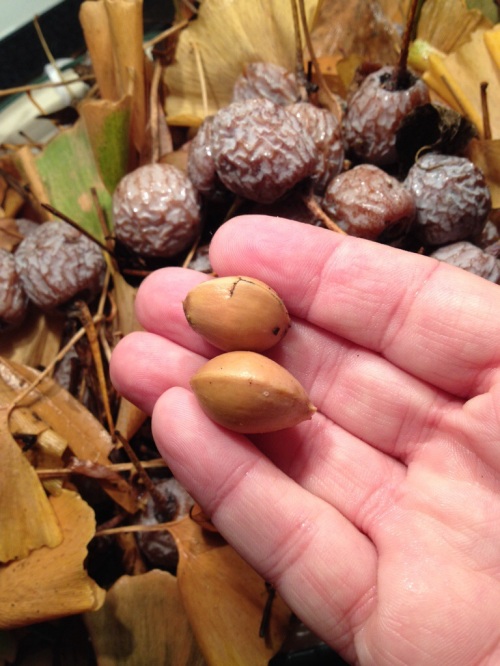The Ginkgo tree (Ginkgo biloba) has an unusual history. It is considered a living fossil as it has been found in fossils over 250 million years old. It was once thought to be extinct until a few small populations were discovered in China. The leaves are fan-shaped and deciduous. They become a bright gold color before falling in Autumn. A common nickname is Maidenhair Tree because the leaves resemble the Maidenhair Fern. The trees are dioecious with separate sexes so the trees are either male or female. There are a few cultivars with unusual shaped leaves. They grow up to 75 feet with large trunks.
Botanically the ginkgo is in its own group amoung seed producing (spermatophytesspermatophytes) plants because it has not been decided if it should be in the conifer (cone-bearing) group or in the angiosperm (flowering plant) group.
Near NC State University there are two very old and large ginkgo trees in an old apartment complex. One is a large female which produces tons of fruit. The nut in the fruits are highly valued in Asia. They are usually roasted and the traditional way to roast the nut in China is to let the fruit rot then roast the nut.
I also wanted to collect the fruit to plant them along the back fence line and allow a forest of ginkgo trees to developed. They only grow a few inches a year so it would be decades before I see anything. The fruit has a strong musky fragrance and usually only male trees are planted for the beautiful Fall yellow leaves. There are weeping forms and forms with unusual shaped leave. It can take 20 years to fruit from seed so maybe in my old age I will see a fruiting tree in my yard?
Below is the fruit I collected from the Snow Street trees. They were covering the ground but you could not smell anything fragrance unless you held them up to you nose. Culturally, females trees are usually not planted because the flesh of the fruit is supose to be unpleasant and messy.
Inside the musky and pungent flesh is a white nut which looks like a pistachio.
The flesh is green just like a pistachio. The flavor is somewhat nut like and reminds me of a pine nut. The fruit and the nut contains chemicals (urushiol) which may cause those sensitive to break out or have some skin irritation. It’s a good idea to wash your hands after handling them and to not touch your eyes or other mucus membranes before washing your hands to prevent irritation.
The nuts are mildly toxic and are usually roasted or boiled.
To boil: cover with water and boil for about 10 minutes with about a tablespoon of salt. Crack the thin shell by placing the flat side of a knife on the nut then hitting it with your palm like you do garlic.
To roast: in a frying pan, add a tablespoon of vegetable oil, and then the nuts and a teaspoon of salt. Cook over medium-high heat until the shells split. Remove from heat and let cool enough to handle. Remove the shells and the paper-like outer skin.
There are selected clones available from nurseries developed for heavy nut production along with all the male clones with unusal upright, weeping, and horizontal growth patterns.
xxx







I love Ginkgos. I have a small dwarf called Jade Butterflies in my garden and it’s beautiful and it’s history is fascinating. I went to school at an aggie college years ago and they had inadvertently planted female tress all thru the area around some buildings and the whole place smelled like dog poop when they put out fruit. Yukky to the max! And a joke on them as a school for plant nuts…. I’ve never tried to harvest them but have seen the Chinese people in Golden Gate Park in SF do so. They taste good too I’ve found. Very yummy in Asian cuisine…
Nice post. Thank you!
Steve
LikeLike
Thanks!
LikeLike
Interesting. The only ginkos I’ve worked with or near were quite young and didn’t bear fruit. Do they taste good?
LikeLike
Most of the cultivated varieties are male just for the fact they do not produce the messy fruit.
They do not have much of a flavor to me. Sort of a bland pistacio.
LikeLike
They have a nutty taste similar to pistachios.
LikeLike
I wanna collect ginkgo nuts, too! Sounds like fun :-). But I haven’t seen any trees bearing fruits around here. The fall leaves are beautiful! — Angie.
LikeLike
🙂
LikeLike
Personally I think I’d prefer hazelnuts.
LikeLike
I agree! 🙂
LikeLike
Good luck with your ginko forest! This is one of the favorite trees of our local arborists.
LikeLike
Oh wow!I’ve never seen Gingko before.They do look like pistachios!
LikeLike
Female trees are rarely planted! They do drop a ton of fruit so they can be messy!
LikeLike
Wow, so much valuable information here. I would love to experiment with some Ginkgos – thanks for this!!
LikeLike
You can usually find them in Chinese and Asian food stores.
LikeLike